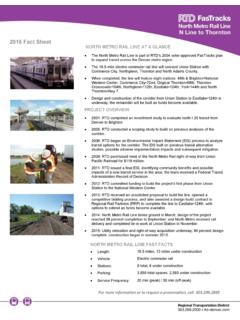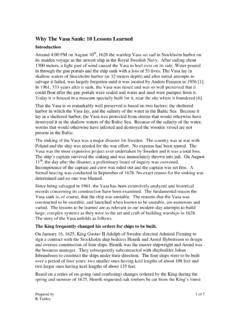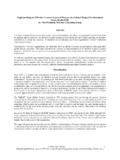Transcription of Lessons Learned Master Document FINAL - 9-11-09
1 FasTracks 2009 Lessons Learned Report 1 Table of Contents Executive Summary .. 3 Lessons Learned .. 4 FasTracks Program Background .. 5 FasTracks 2009 Lessons Learned Master Contact List .. 7 Planning/Environmental Studies .. 8 1. Overview .. 8 2. Background .. 8 3. The Lessons .. 9 Cost Estimating .. 10 1. Overview .. 10 2. Background .. 11 3. The Lessons .. 12 Revenue Forecasting .. 13 1. Overview .. 13 2. Background .. 13 3. The Lessons .. 14 Railroad Right-of-Way .. 15 1. Overview .. 15 2. Background .. 16 3. The Lessons .. 17 Property Acquisition .. 18 1. Overview .. 18 2. Background .. 18 3. The Lessons .. 19 Management .. 20 1. Overview .. 20 2. Background .. 20 3. The Lessons .. 21 Processes/Procedures .. 23 1. Overview .. 23 2. Background .. 23 3. The Lessons .. 23 Project Delivery .. 25 FasTracks 2009 Lessons Learned Report 2 1. Overview .. 25 2. Background .. 25 3. The Lessons .. 26 Communications .. 27 1. Overview .. 27 2. Background.
2 27 3. The Lessons .. 28 FasTracks at Work .. 29 Acronym List .. 32 FasTracks 2009 Lessons Learned Report 3 Executive Summary Every major program has something to learn from its experiences. The FasTracks program is currently one of the most ambitious transit expansion efforts in the nation. The Regional Transportation District (RTD) has built four light rail projects on time and on budget and has drawn upon the many Lessons Learned on each of those individual projects to develop the long-range FasTracks program. A program of this magnitude is a unique venture that is positioned to benefit not only from the Lessons of the past, but also to present a whole new slate of experiences that emerge from its trailblazing nature. Nearly five years into the implementation of FasTracks, RTD has taken a look back at what s gone well from the start and what we will do differently given what we know now as the program moves forward.
3 These insights come together as the first FasTracks Lessons Learned Report. The report is presented as nine main categories that break down into a number of Lessons within each topic area. The key Lessons we ve Learned are summarized below. Planning/Environmental Studies We ve Learned to appropriately staff projects from day one with experienced planning and engineering project managers and support personnel; to allot three to five years in the schedule for future planning/environmental studies; and that many third-party requested changes in plans or requirements require significant analysis that can delay studies. Cost Estimating We ve Learned that it s beneficial to provide a program-wide contingency to cover uncertainty and unknown issues rather than relying only on individual corridor contingencies; to maintain a 30% cost contingency until design reaches 30%; and to advance engineering to identify risks and the costs associated with them, ensuring the FasTracks plan is shovel-ready before requesting any additional tax increase to construct the projects.
4 Revenue Forecasting We ve Learned that it is more prudent to provide a range (best-case and worst-case cash flows) of potential sales and use tax collections, rather than an exact figure, for longer-term projections; the importance of educating stakeholders and the public on RTD s forecasting methodologies; and it should be emphasized more clearly that long-term growth projections are averages, rather than exact forecasts of annual growth rates. Railroad Right-of-Way We ve Learned that when establishing a budget for purchasing railroad right-of-way, the actual cost should include a larger corridor enhancement factor to be more on the conservative side; that there should be a greater emphasis on minimizing impacts to railroad operations to help contain the cost of relocation or enhancement; and to allow sufficient time to negotiate to accommodate the railroads approval process by their various departments.
5 FasTracks 2009 Lessons Learned Report 4 Property Acquisition We ve Learned that more direct coordination among internal disciplines is essential to provide consistent communication with potentially impacted property owners as design progresses, always stressing that the acquisition of property takes place following the completion of the formal environmental process; and that designers providing certified rights-of-way plans as early as feasible is key to completing property acquisitions in a timely manner prior to construction. Management We ve Learned that staffing resources must be at a sufficient level to adequately address the demands of the program; that the matrix organization works well as long as each corridor project has an adequate core group of personnel who are fully dedicated to that corridor; and that it s essential to assign full responsibility and FINAL decision-making authority on program implementation to the FasTracks Program Manager, in conjunction with the General Manager and Board of Policies/Procedures We ve Learned that we must focus progress reporting and issue resolution on critical schedule milestones; that integration of FasTracks-specific control systems with overall RTD processes and systems is critical.
6 And that adequate business processes and internal controls need to be in place before entering into joint construction agreements for projects. Project Delivery We ve Learned that design-build, design-build-operate-maintain and design-build-finance-operate-maintain delivery methods bring a significant private sector component into the management of these projects, which maximizes contractor innovation and participation; and that negotiated contract prices are extremely challenging to implement and should be avoided in the future. Communications We ve Learned that it is important to clearly define an overarching Public Information and Public Involvement Program as early in a program as possible; that it is essential to communicate the stakeholder participation process and how involvement opportunities narrow as a project becomes more defined; and that the level of internal communication must accommodate the size and de-centralized nature of a multi-project program.
7 Lessons Learned Lessons Learned are general statements that describe good practices or innovative approaches that are shared to promote repeat application. They may also be descriptions of challenges or areas for improvement that are shared to provide continuous improvement. Effective organizations use past experience as a guide to improve future performance. A program as large and complex as FasTracks is especially prone to offer Lessons that can be used FasTracks 2009 Lessons Learned Report 5 throughout the completion of FasTracks itself, as well as for future programs. As several FasTracks corridors move from the planning to construction phase, it provides an excellent opportunity to reflect on Lessons Learned from the FasTracks program things that have gone well that should be repeated, and things the FasTracks team would recommend be done differently. The FasTracks team intends to apply these Lessons Learned moving forward, to ensure continuous improvement on its implementation of FasTracks and welcomes other agencies and organizations to learn from our experience as well.
8 In addition, FasTracks plans to implement an ongoing Lessons Learned program to capture and update these ongoing experiences throughout the program. FasTracks Program Background FasTracks is the Regional Transportation District s (RTD s) voter-approved, multi-billion dollar program to build 122 miles of rail transit, including six new commuter rail and light rail lines and extensions of three existing lines; build 18 miles of bus rapid transit service, add 21,000 new parking spaces, redevelop Denver Union Station and redirect bus service to better connect the eight-county District. FasTracks is funded through a combination of sources, including the voter-approved sales tax increase of percent (4 pennies on every $10), passed in 2004. RTD has adopted program goals and objectives to guide the implementation of FasTracks. FasTracks Program Guiding Principles Ensure every step contributes to the full vision Focus money available to the greatest good Spend public money wisely Maximize outside funding before returning to taxpayers Deliver key investments in all corridors FasTracks Program Goals Provide improved transportation choices and options to the residents of the District additional transportation choices add to the region's quality of life.
9 Increase transit mode share during peak travel times existing congestion during peak travel times of the day is frustrating for many drivers and is expected to worsen as the region grows. Establish a proactive plan that balances transit needs with future regional growth the Denver metropolitan region is expected to grow from million (2005) people to nearly 4 million in 2030. FasTracks Program Objectives The FasTracks team's mission is to provide a reliable and safe transit system that enhances mobility, responds to the growing transportation needs within the Regional Transportation FasTracks 2009 Lessons Learned Report 6 District, and creates a legacy for current and future generations. The team will accomplish this by achieving the following objectives: Complete the FasTracks investment initiative Provide a quality program and transit system Ensure public and transit system safety Minimize negative impacts to the community Provide timely, accurate, clear, and consistent information to the public Create opportunities for Small and Disadvantaged Business Enterprises FasTracks An Economic Driver FasTracks is projected to create more than 10,000 construction jobs alone during the height of construction.
10 Economists estimate that every $1 invested in transportation infrastructure translates into $6 of local economic activity. The FasTracks investment initiative will pump billions of dollars into the regional economy. FasTracks 2009 Lessons Learned Report 7 FasTracks 2009 Lessons Learned Master Contact List Phillip A. Washington RTD Interim General Manager 1600 Blake Street Denver, CO 80202 Richard F. Clarke Acting Assistant General Manager, FasTracks / Engineering 1560 Broadway, Suite 700 Denver, CO 80202 William C. Van Meter Acting Assistant General Manager, Planning 1560 Broadway, Suite 700 Denver, CO 80202 Scott Reed Assistant General Manager, Public Affairs 1600 Blake Street Denver, CO 80202 Pauletta Tonilas FasTracks Public Information Manager 1560 Broadway, Suite 700 Denver, CO 80202 Project Web Site: FasTracks 2009 Lessons Learned Report 8 lesson Learned # 1 Planning/Environmental Studies 1.






